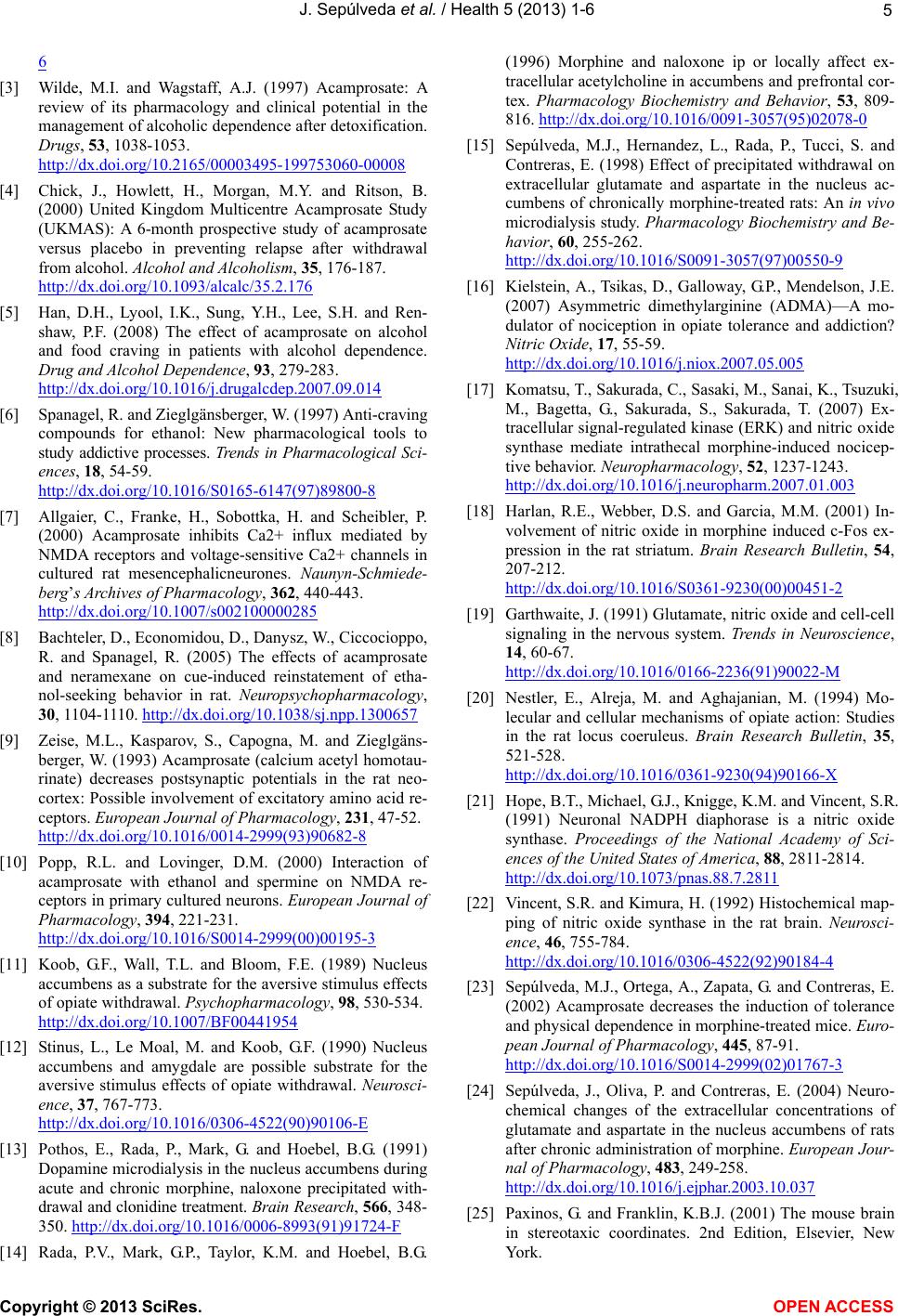
J. Sepúlveda et al. / Health 5 (2013) 1-6 5
6
[3] Wilde, M.I. and Wagstaff, A.J. (1997) Acamprosate: A
review of its pharmacology and clinical potential in the
management of alcoholic dependence after detoxification.
Drugs, 53, 1038-1053.
http://dx.doi.org/10.2165/00003495-199753060-00008
[4] Chick, J., Howlett, H., Morgan, M.Y. and Ritson, B.
(2000) United Kingdom Multicentre Acamprosate Study
(UKMAS): A 6-month prospective study of acamprosate
versus placebo in preventing relapse after withdrawal
from alcohol. Alcohol and Alcoholism, 35, 176-187.
http://dx.doi.org/10.1093/alcalc/35.2.176
[5] Han, D.H., Lyool, I.K., Sung, Y.H., Lee, S.H. and Ren-
shaw, P.F. (2008) The effect of acamprosate on alcohol
and food craving in patients with alcohol dependence.
Drug and Alcohol Dependence, 93, 279-283.
http://dx.doi.org/10.1016/j.drugalcdep.2007.09.014
[6] Spanagel, R. and Zieglgänsberger, W. (1997) Anti-craving
compounds for ethanol: New pharmacological tools to
study addictive processes. Trends in Pharmacological Sci-
ences, 18, 54-59.
http://dx.doi.org/10.1016/S0165-6147(97)89800-8
[7] Allgaier, C., Franke, H., Sobottka, H. and Scheibler, P.
(2000) Acamprosate inhibits Ca2+ influx mediated by
NMDA receptors and voltage-sensitive Ca2+ channels in
cultured rat mesencephalicneurones. Naunyn-Schmiede-
berg’s Archives of Pharmacology, 362, 440-443.
http://dx.doi.org/10.1007/s002100000285
[8] Bachteler, D., Economidou, D., Danysz, W., Ciccocioppo,
R. and Spanagel, R. (2005) The effects of acamprosate
and neramexane on cue-induced reinstatement of etha-
nol-seeking behavior in rat. Neuropsychopharmacology,
30, 1104-1110. http://dx.doi.org/10.1038/sj.npp.1300657
[9] Zeise, M.L., Kasparov, S., Capogna, M. and Zieglgäns-
berger, W. (1993) Acamprosate (calcium acetyl homotau-
rinate) decreases postsynaptic potentials in the rat neo-
cortex: Possible involvement of excitatory amino acid re-
ceptors. European Journal of Pharmacology, 231, 47-52.
http://dx.doi.org/10.1016/0014-2999(93)90682-8
[10] Popp, R.L. and Lovinger, D.M. (2000) Interaction of
acamprosate with ethanol and spermine on NMDA re-
ceptors in primary cultured neurons. European Journal of
Pharmacology, 394, 221-231.
http://dx.doi.org/10.1016/S0014-2999(00)00195-3
[11] Koob, G.F., Wall, T.L. and Bloom, F.E. (1989) Nucleus
accumbens as a substrate for the aversive stimulus effects
of opiate withdrawal. Psychopharmacology, 98, 530-534.
http://dx.doi.org/10.1007/BF00441954
[12] Stinus, L., Le Moal, M. and Koob, G.F. (1990) Nucleus
accumbens and amygdale are possible substrate for the
aversive stimulus effects of opiate withdrawal. Neurosci-
ence, 37, 767-773.
http://dx.doi.org/10.1016/0306-4522(90)90106-E
[13] Pothos, E., Rada, P., Mark, G. and Hoebel, B.G. (1991)
Dopamine microdialysis in the nucleus accumbens during
acute and chronic morphine, naloxone precipitated with-
drawal and clonidine treatment. Brain Research, 566, 348-
350. http://dx.doi.org/10.1016/0006-8993(91)91724-F
[14] Rada, P.V., Mark, G.P., Taylor, K.M. and Hoebel, B.G.
(1996) Morphine and naloxone ip or locally affect ex-
tracellular acetylcholine in accumbens and prefrontal cor-
tex. Pharmacology Biochemistry and Behavior, 53, 809-
816. http://dx.doi.org/10.1016/0091-3057(95)02078-0
[15] Sepúlveda, M.J., Hernandez, L., Rada, P., Tucci, S. and
Contreras, E. (1998) Effect of precipitated withdrawal on
extracellular glutamate and aspartate in the nucleus ac-
cumbens of chronically morphine-treated rats: An in vivo
microdialysis study. Pharmacology Biochemistry and Be-
havior, 60, 255-262.
http://dx.doi.org/10.1016/S0091-3057(97)00550-9
[16] Kielstein, A., Tsikas, D., Galloway, G.P., Mendelson, J.E.
(2007) Asymmetric dimethylarginine (ADMA)—A mo-
dulator of nociception in opiate tolerance and addiction?
Nitric Oxide, 17, 55-59.
http://dx.doi.org/10.1016/j.niox.2007.05.005
[17] Komatsu, T., Sakurada, C., Sasaki, M., Sanai, K., Tsuzuki,
M., Bagetta, G., Sakurada, S., Sakurada, T. (2007) Ex-
tracellular signal-regulated kinase (ERK) and nitric oxide
synthase mediate intrathecal morphine-induced nocicep-
tive behavior. Neuropharmacology, 52, 1237-1243.
http://dx.doi.org/10.1016/j.neuropharm.2007.01.003
[18] Harlan, R.E., Webber, D.S. and Garcia, M.M. (2001) In-
volvement of nitric oxide in morphine induced c-Fos ex-
pression in the rat striatum. Brain Research Bulletin, 54,
207-212.
http://dx.doi.org/10.1016/S0361-9230(00)00451-2
[19] Garthwaite, J. (1991) Glutamate, nitric oxide and cell-cell
signaling in the nervous system. Trends in Neuroscience,
14, 60-67.
http://dx.doi.org/10.1016/0166-2236(91)90022-M
[20] Nestler, E., Alreja, M. and Aghajanian, M. (1994) Mo-
lecular and cellular mechanisms of opiate action: Studies
in the rat locus coeruleus. Brain Research Bulletin, 35,
521-528.
http://dx.doi.org/10.1016/0361-9230(94)90166-X
[21] Hope, B.T., Michael, G.J., Knigge, K.M. and Vincent, S.R.
(1991) Neuronal NADPH diaphorase is a nitric oxide
synthase. Proceedings of the National Academy of Sci-
ences of the United States of America, 88, 2811-2814.
http://dx.doi.org/10.1073/pnas.88.7.2811
[22] Vincent, S.R. and Kimura, H. (1992) Histochemical map-
ping of nitric oxide synthase in the rat brain. Neurosci-
ence, 46, 755-784.
http://dx.doi.org/10.1016/0306-4522(92)90184-4
[23] Sepúlveda, M.J., Ortega, A., Zapata, G. and Contreras, E.
(2002) Acamprosate decreases the induction of tolerance
and physical dependence in morphine-treated mice. Euro-
pean Journal of Pharmacology, 445, 87-91.
http://dx.doi.org/10.1016/S0014-2999(02)01767-3
[24] Sepúlveda, J., Oliva, P. and Contreras, E. (2004) Neuro-
chemical changes of the extracellular concentrations of
glutamate and aspartate in the nucleus accumbens of rats
after chronic administration of morphine. European Jour-
nal of Pharmacology, 483, 249-258.
http://dx.doi.org/10.1016/j.ejphar.2003.10.037
[25] Paxinos, G. and Franklin, K.B.J. (2001) The mouse brain
in stereotaxic coordinates. 2nd Edition, Elsevier, New
York.
Copyright © 2013 SciRes. OPEN A CCES S